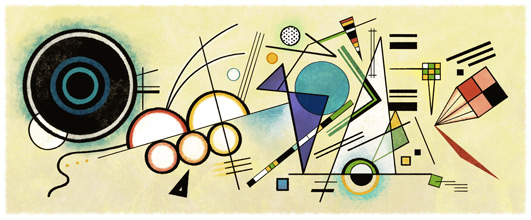
The Guardian says:
Like symphonies, Kandinsky’s great abstract paintings speak directly to our senses and feelings. Their constellations of mysterious marks are like waves of sound that trigger emotions. For him, the world they pointed towards was a spiritual realm, a hidden truth.The Telegraph says:
Despite the lack of medical proof for Kandinsky's synaesthesia, the correlation between sound and colour was a lifelong preoccupation for the artist. He recalled hearing a strange hissing noise when mixing colours in his paintbox as a child, and later became an accomplished cello player, which he said represented one of the deepest blues of all instruments.... Kandinsky discovered his synaesthesia at a performance of Wagner's opera Lohengrin in Moscow: "I saw all my colours in spirit, before my eyes. Wild, almost crazy lines were sketched in front of me."The Independent:
Fifty seven of his paintings were confiscated by the Nazis during a raid on the Bauhaus art school and were later put on show in the State-sponsored exhibit “Degenerate Art” in 1937 before being destroyed.I recommend Kandinsky's book "Concerning the Spiritual in Art" (free Kindle edition).




10 comments:
Were it not for Google many would have let pass Kandinsky's 148th birthday unobserved.
It looks like all the anxieties that I resolved as a child. Apparently, someone thought they were art.
Thank you Professor. You have again expanded my horizons.
You'd think Google would save it for the 150th birthday, but maybe there is something to the number 148.
"148 is the second number to be both a heptagonal number and a centered heptagonal number (the first is 1). 148 is the twelfth member of the Mian–Chowla sequence. There are 148 perfect graphs with 6 vertices."
From the Wikipedia article on the number 148.
From the Wikipedia article on the number 148.
The smallest positive integer without its very own Wikipedia page is 253.
Reminds me of the general-curriculum class on modern art that I took in college.
The students nicknamed the class "Spots and Dots".
I first really became familiar with Kandinksy in seminary, oddly enough. A theology and art class with Bill Dyrness. I forget if Kandinsky's Concerning the Spiritual in Art was a required book or not, but I know I read it that quarter.
As part of that class we had a field trip to the Norton Simon with Dyrness and a art professor colleague from UC Berkeley. Amazing to go through the halls of that great art and hear engaged scholars talk about it.
That class helped me finally get modern art. Kandinsky's circle theme actually sparked some theological musing and really has been a key, if behind the scenes, part of my intellectual development. I was drawn to his paintings and then thought about why that would be, what he was getting at, why it was getting into my head the way it was.
Good stuff. The book is wonderful.
Paddy O, I went to an art show a few years ago, and one of the critics commented on one painting by saying something like "circles are out of fashion".
So...isosceles triangles, maybe?
madAsHell said...
It looks like all the anxieties that I resolved as a child. Apparently, someone thought they were art.
To me they look like spilled food, possibly post-consumption.
Real art.
Bob, Kandinsky has already been there too.
Real artists nowadays can't let them be constrained by 4 dimensions.
Post a Comment
Please use the comments forum to respond to the post. Don't fight with each other. Be substantive... or interesting... or funny. Comments should go up immediately... unless you're commenting on a post older than 2 days. Then you have to wait for us to moderate you through. It's also possible to get shunted into spam by the machine. We try to keep an eye on that and release the miscaught good stuff. We do delete some comments, but not for viewpoint... for bad faith.